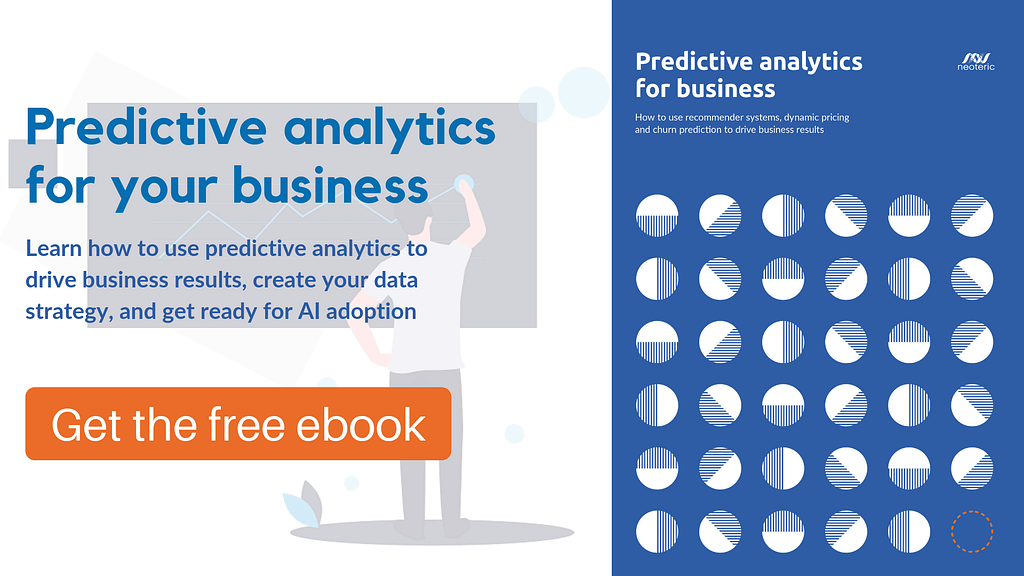The sins of AI adopters
Artificial intelligence adoption may be tricky. It’s a technology different than any other you’ve implemented before. There are rules to follow, some of them incomprehensible to someone without extensive AI knowledge. There are certain challenges companies can face while implementing AI: data quality, model errors, lack of data science experts – many of them covered in the article 12 challenges of AI adoption. Some of these issues can be prevented, others require preparation. However, many organizations are still dreamers when it comes to AI. There’s nothing wrong with having a vision to follow, but the way you follow it matters.
In the upcoming weeks, we’ll share a series of articles covering “the sins of AI adopters”, or mistakes of AI adoption, where we’ll cover some of the common mistakes organizations make when beginning their AI journey – and show you how to avoid making them.
Unrealistic expectations and lack of data strategy
These 2 elements like going together and are often true for a lot of organizations who already know they should keep an eye on AI tech. They might be needing it soon. How do they know they might be needing it? Well, they watch their competitors and see newly implemented features, they watch market leaders and take notes of what works and what doesn’t, and they were also told that AI is the future.
However, unrealistic expectations make many projects fail, even at early stages. Let’s see how.
Scenario 1: Copying the cool kids
Copying the cool kids may be a strategy to follow to live through high school, but not so much in business. Following the money is what makes the most sense. So even if Amazon has AI implemented in X number of functionalities, why would you do the exact same?
Many organizations are tempted to follow the lead of the biggest players, and it’s understandable. They’re successful, so it’s just logical to assume that what they do makes sense. However, companies like Amazon have gathered enough capital to test various, even crazy solutions. They can afford it, and experimenting with technology is great. However, smaller companies cannot afford to take so much risk.
Observing the giants, learning from their successes and failures – that does bring value. But keep in mind that each business is different and has different needs. Don’t let yourself lose sight of what matters to you. Do some research, get your strategy ready, and then – go and rock the market.
Scenario 2: Being a hopeless optimist
Of course, it will work! What could possibly go wrong?
You should always believe in the success of your project, otherwise why go for it in the first place? But you know what they say… Hope for the best, but prepare for the worst. Implementing a new piece of technology can be challenging, and that’s something organizations have to remember. AI is not a magical tool – it needs the right use case matching your objectives, the right data, and success criteria, it also has certain limitations. When you identify the area you think is right for you, e.g. you want to develop a recommender system, learn both the possibilities it offers, and the limitations it has. It’s an important part of the process to know what AI can do for your business, realistically, and be able to later track the performance of the deployed model.
Scenario 3: Going for perfection
Let’s settle this once and for all: there is no such thing as perfection. Even for AI. AI also makes mistakes. No model will be 100% error-free. The right strategy will help your organization avoid your AI failing bad (just have a look at these AI fails), and that’s what you should do. Be realistic, be prepared, be strategic.
The scenarios described above are just some examples of how unrealistic expectations and the lack of strategic approach get in the way. There are many mistakes companies can make, and if you made some, too – share your experience with others. There’s no shame in that, that’s your learning process.
Surprisingly, many of the mistakes companies make can be predicted (without a predictive model, really!) and prevented. Early on in the process of AI adoption, there is a need for more thorough understanding – not just of the tech, but of business, too. Discussing your ideas with domain experts (your staff who will use the models) and data scientists will help you crystallize the exact need. Identifying the right business use case and starting small is crucial to validate the concept of AI in your company and mitigate the risk of wasting money for a “cool” addition that brings no tangible value. That’s also why I often emphasize the importance of having a data strategy for your organization. Let me explain why.

Do you need a data strategy?
The importance of data strategy is often underestimated. In the past, data was just a byproduct of processes and business activities. It’s different now. Data is the most valuable resource that allows companies to gain competitive advantage and come up with new ways of improving their operations. Many companies now appreciate the value of data – they use analytics, study trends, excel at reporting. However, fewer have adjusted to a more data-centered approach focused on capturing and managing data assets. Organizations need data strategies that cover the current state of business and technology but also future objectives.
As defined by SAS:
Data strategy is a plan designed to improve all the ways you acquire, store, manage, share, and use data.
A data strategy ensures that the data collected by the company is actually managed like an asset. Data strategy includes elements of business strategy, goals for the project, data requirements, KPIs. Each data strategy may be different and consist of various elements, adjusted to the organization’s needs.
The creation of a data strategy usually requires the analysis and planning of the following:
Business case
Your data strategy cannot work separate from your business strategy. You want to use data to drive business results, so the first step is to look at the business objectives and priorities. Then, you make a business case where you identify ways to use data to address these priorities. Your data strategy doesn’t have to cover all of the possible use cases you come up with. Focus on what’s doable. Select a few use cases to start with.
Objectives and quick wins
What’s the long-term goal of your data science project? You probably know it already, and it’s a very important element of your strategy, but you also need quick wins – shorter-term goals. These should be fast and rather inexpensive, and they deliver value right away.

Data requirements
It’s time to answer some questions considering data.
- What data do you need? Where will this data come from?
- Is internal data enough or do you also need external data (e.g. from social media)?
- What data do you already have?
There are also questions related to data governance:
- How to ensure data is stored in a secure way?
- Who’s responsible for data-handling?
- How to make sure your use of data is GDPR-compliant as well as ethical?
And you should consider these issues, too:
- How is data collected, stored, and organized?
- Do you have an efficient data pipeline?
- What technologies are you considering for your project and what are the technical requirements (like hardware, software)?
- How will the results provided by the model be interpreted?
Skills and know-how
Apart from the technological aspects, you should also consider your team composition. Do you have the skills you need to deliver the project? Do you want to train your staff? Hire an in-house data science team? Do you want to partner with another company?
Core activities
With the business cases selected, tech and staff requirements analyzed, you can outline the activities that have to be performed during the process. You don’t have to design a very detailed project roadmap, but identifying core activities will go together with identifying the skills and know-how you need in the project.
KPIs and metrics
Identify appropriate KPIs to verify whether your project is on track. Check these on a short-term and long-term basis, and adjust if necessary. No strategy can be pursued without KPIs – a strategic approach cannot be lacking information about progress, success or failure, and relevant metrics.
Data-driven culture
Your staff will have to learn how to work with AI solutions and how to use the insights in their everyday work. You need to make sure it becomes their habit to make data-driven decisions. Data-driven organizations have processes that enable employees to acquire the information they need, but they also have clear rules on data access and governance.
Don’t theorize before you have data
It’s a capital mistake to theorize before one has data, said Sherlock Holmes. He was right. Companies understand the value hiding in their data and want to unlock its potential with AI. The idea is great, however, thinking about data, they forget to follow the same rules with validating the idea for the use case… Use data – information – to make the decisions at every step of the way. Why is this use case good? What data do you need? What data do you have? How will the results help your staff? How do you measure success? The answers to these (and more) important questions provide you with valuable insights and guidance on where to go. Do make assumptions, but realistic ones. And make sure you verify them.

